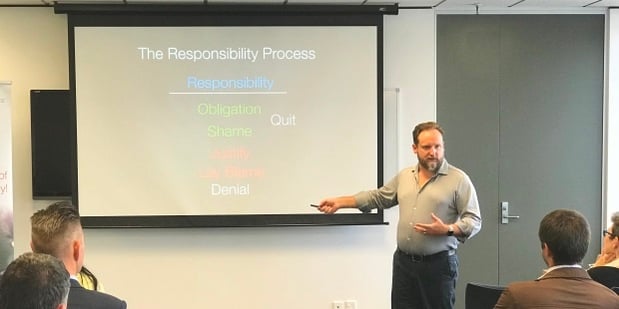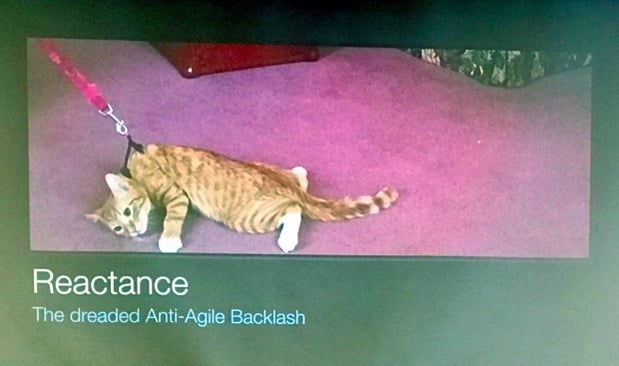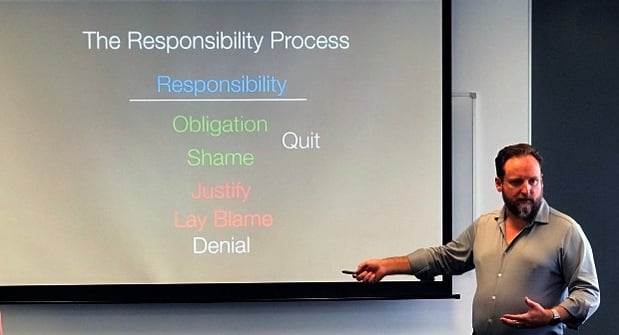Share this
Simon Bennett presents on why the Responsibility Process® is key to Agile success
by Brendon Livingstone on 15 March 2018

Agile adoptions and transformations are very common in New Zealand organisations right now, but many find it hard to achieve the buy-in and culture change required to make Agile stick.
We were excited to host an IT executive event at Equinox IT on Tuesday evening where Simon Bennett presented on 'Why the Responsibility Process® is the key to succeeding with Agile'.
Simon is the Managing Principal of LASTing Benefits a boutique consultancy operating in both Australasia and Europe. While Simon was in New Zealand working with Equinox IT to deliver Certified ScrumMaster and Certified Scrum Product Owner training, his expertise is far broader than Scrum, also covering Lean, systems thinking, complexity science, and organisational change.
Simon's talk was hilariously presented and resonated with the audience by calling out and addressing the often-unstated realities when it comes to Agile adoption and transformation.
In this blog post I summarise my interpretation of some of the points Simon made...
Why Agile transformation doesn't work
Simon has been working with Agile since well before it was called Agile and over the years has given a lot of thought to why the approach sometimes sticks and works and often times doesn't stick and fails. Simon has found that Agile normally will not work in these circumstances:
Too much focus on the mechanics of Agile
The first and most fundamental Agile Value is “Individual and Interactions over Processes and Tools”. It reminds us that Agile is fundamentally about people who do the work and its people who are called on to respond to change.
Over the years, many organisations have struggled to adopt Agile successfully because they prioritise getting the mechanics (process, practices, frameworks) right instead of working more directly with the people.
Waterfall in Agile clothing
People are very resourceful at finding ways of continuing to do waterfall. We see this manifest in ways such as "command and control Agile".
Agile is not a culture that can be adopted
It is popular to talk about Agile as a culture and that organisations need to adopt an 'Agile culture'. However, Simon argued that culture is not adopted. Culture changes through invasion and colonialism, in other words by external force. It is unlikely to help your Agile transformation if you need to violently apply an Agile culture.
The Agile Manifesto doesn't help
The Agile Manifesto signed in 2001 was a 'call to arms'. The many individuals and teams practicing new and smart ways of developing software could rally behind a shared name and set of values. It is descriptive and not directive and it becomes an excuse generator for people who do not want to take responsibility. For example, 'Individuals and interactions over processes and tools' becomes the excuse of 'no rules' and 'Working software over comprehensive documentation' becomes the excuse of 'no documentation', even though this is not the intent of those values. The Agile Manifesto doesn't help organisations trying to adopt or transform to Agile.
Bottom-up 'grass roots' Agile lacks management buy-in
Many teams adopt Agile by copying others and 'just doing it'. This is a slow and organic approach to Agile adoption that creates local optimisation. Leaders who are looking at what is optimal across their organisation are inclined to stamp out or limit this initiative that started without their permission.
Top-down Agile creates reactance
As per Simon's presentation image of the cat below, reactance occurs when choices are reduced and the person (or animal) responds by strengthening their conviction to do the opposite of what is desired.
"Let's roll out Agile", "we need to run an Agile transformation", "employ a scaling framework", "send in the Agile coaches", "make teams self-organise". Management mandated Agile adoption will cause reactance and an anti-Agile backlash.

'Outside in' doesn't work, so try 'inside out'
Organisations don't adopt Agile, people do.
Agile adoption and transformation doesn't work when it is invasion, colonialism, bottom-up, top-down. These are all 'outside in' approaches - people trying to control people.
The alternative is 'inside out'. People changing themselves. Agile occurs when people take responsibility.
The Responsibility Process®
The Responsibility Process is a mental ladder that we all go through when faced with a situation. How we handle the situation is determined by what level we step off the ladder.

Low functioning people will deny they have an issue when facing a situation. As you step up the ladder people blame others, justify their actions, feel shame (blame themselves), and feel obligated to do something (but don't really want to). Because shame and obligation is often painful to the individual, they respond by looking to escape the pain by disengaging or checking out (quitting).
The constructive way to behave is above the line, to recognise that you have the power to solve the situation and to take responsibility and solve it.
Clearly, the Responsibility Process is applicable to all aspects of life, not just Agile.
The Responsibility Process and Agile
The engine of waterfall is denial, blame and justification. That is what all of the documentation and sign-off is for.
In Agile the team is self-organising and everybody is mutually accountable. The ScrumMaster is servant leader. The Product Owner is responsible for the organisation's return on investment and for prioritising the development team's work. Making an Agile project work requires each of these people taking individual responsibility. An agile project cannot be successful with a Product Owner who is disengaged from the process, or blaming the project team, or involved only because they feel obligated. So, Agile projects won't work if key team members are denying issues, blaming others or themselves, justifying their actions, doing stuff out of obligation or disengaging.
Responsibility only works when it is self-applied from the inside out. As people start to act with responsibility it can be contagious to other people around them.
In Agile, we need to work towards responsible individuals having responsible interactions.
Many thanks to Simon for spending time with us in New Zealand delivering Scrum training and for his excellent and mind-expanding presentation.
Share this
- Agile Development (153)
- Software Development (126)
- Agile (76)
- Scrum (66)
- Application Lifecycle Management (50)
- Capability Development (47)
- Business Analysis (46)
- DevOps (43)
- IT Professional (42)
- Equinox IT News (41)
- Agile Transformation (38)
- IT Consulting (38)
- Knowledge Sharing (36)
- Lean Software Development (35)
- Requirements (35)
- Strategic Planning (35)
- Solution Architecture (34)
- Digital Disruption (32)
- IT Project (31)
- International Leaders (31)
- Digital Transformation (26)
- Project Management (26)
- Cloud (25)
- Azure DevOps (23)
- Coaching (23)
- IT Governance (23)
- System Performance (23)
- Change Management (20)
- Innovation (20)
- MIT Sloan CISR (15)
- Client Briefing Events (13)
- Architecture (12)
- Working from Home (12)
- IT Services (10)
- Data Visualisation (9)
- Kanban (9)
- People (9)
- Business Architecture (8)
- Communities of Practice (8)
- Continuous Integration (7)
- Business Case (4)
- Enterprise Analysis (4)
- Angular UIs (3)
- Business Rules (3)
- Java Development (3)
- Lean Startup (3)
- Satir Change Model (3)
- API (2)
- Automation (2)
- GitHub (2)
- Scaling (2)
- Toggles (2)
- .Net Core (1)
- Diversity (1)
- Security (1)
- Testing (1)
- February 2024 (3)
- January 2024 (1)
- September 2023 (2)
- July 2023 (3)
- August 2022 (4)
- August 2021 (1)
- July 2021 (1)
- June 2021 (1)
- May 2021 (1)
- March 2021 (1)
- February 2021 (2)
- November 2020 (2)
- September 2020 (1)
- July 2020 (1)
- June 2020 (3)
- May 2020 (3)
- April 2020 (2)
- March 2020 (8)
- February 2020 (1)
- November 2019 (1)
- August 2019 (1)
- July 2019 (2)
- June 2019 (2)
- April 2019 (3)
- March 2019 (2)
- February 2019 (1)
- December 2018 (3)
- November 2018 (3)
- October 2018 (3)
- September 2018 (1)
- August 2018 (4)
- July 2018 (5)
- June 2018 (1)
- May 2018 (1)
- April 2018 (5)
- March 2018 (3)
- February 2018 (2)
- January 2018 (2)
- December 2017 (2)
- November 2017 (3)
- October 2017 (4)
- September 2017 (5)
- August 2017 (3)
- July 2017 (3)
- June 2017 (1)
- May 2017 (1)
- March 2017 (1)
- February 2017 (3)
- January 2017 (1)
- November 2016 (1)
- October 2016 (6)
- September 2016 (1)
- August 2016 (5)
- July 2016 (3)
- June 2016 (4)
- May 2016 (7)
- April 2016 (13)
- March 2016 (8)
- February 2016 (8)
- January 2016 (7)
- December 2015 (9)
- November 2015 (12)
- October 2015 (4)
- September 2015 (2)
- August 2015 (3)
- July 2015 (8)
- June 2015 (7)
- April 2015 (2)
- March 2015 (3)
- February 2015 (2)
- December 2014 (4)
- September 2014 (2)
- July 2014 (1)
- June 2014 (2)
- May 2014 (9)
- April 2014 (1)
- March 2014 (2)
- February 2014 (2)
- December 2013 (1)
- November 2013 (2)
- October 2013 (3)
- September 2013 (2)
- August 2013 (6)
- July 2013 (2)
- June 2013 (1)
- May 2013 (4)
- April 2013 (5)
- March 2013 (2)
- February 2013 (2)
- January 2013 (2)
- December 2012 (1)
- November 2012 (1)
- October 2012 (2)
- September 2012 (3)
- August 2012 (3)
- July 2012 (3)
- June 2012 (1)
- May 2012 (1)
- April 2012 (1)
- February 2012 (1)
- December 2011 (4)
- November 2011 (2)
- October 2011 (2)
- September 2011 (4)
- August 2011 (2)
- July 2011 (3)
- June 2011 (4)
- May 2011 (2)
- April 2011 (2)
- March 2011 (3)
- February 2011 (1)
- January 2011 (4)
- December 2010 (2)
- November 2010 (3)
- October 2010 (1)
- September 2010 (1)
- May 2010 (1)
- February 2010 (1)
- July 2009 (1)
- April 2009 (1)
- October 2008 (1)